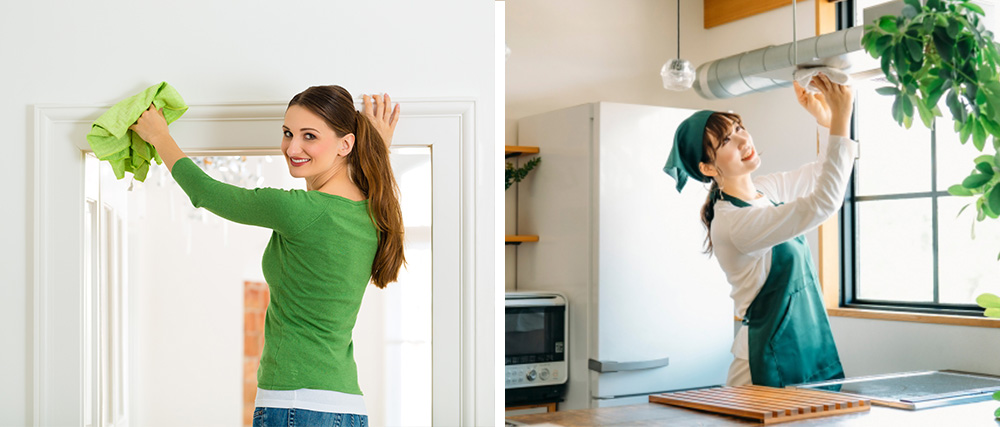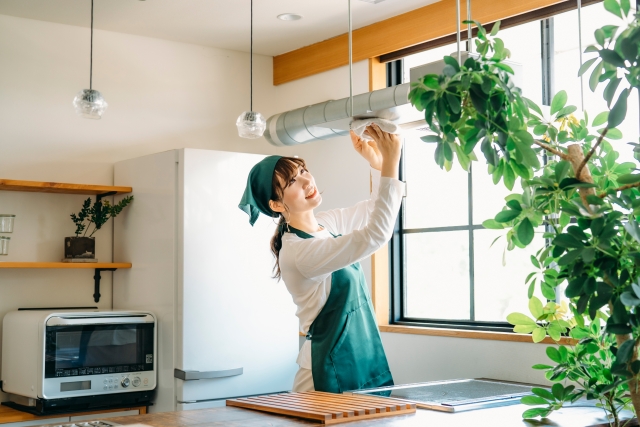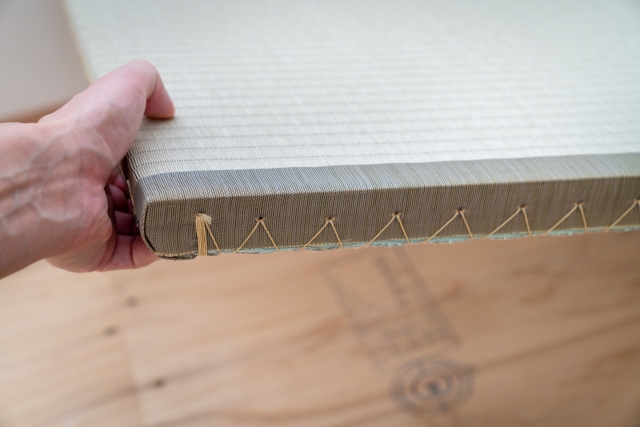Spring Cleaning vs. Ōsōji: Which One Fits Your Lifestyle? A Deep Dive into U.S. and Japanese Cleaning Cultures!

Introduction: The Difference Between Deep Cleaning in the U.S. and Japan
Cleaning is essential for maintaining a comfortable living space, but the timing, methods, and purpose behind it vary greatly across cultures.
In the U.S., Spring Cleaning typically takes place between March and April, marking the end of winter. It’s a tradition centered around thorough cleaning and refreshing the home to welcome the new season.
In contrast, Japan’s Ōsōji (大掃除) is traditionally done at the end of the year. This practice is rooted in the cultural belief of purifying the home to prepare for the New Year. In traditional Japanese homes, where tatami mats are common, this process sometimes includes “tatami-age”—lifting the tatami mats for deep cleaning underneath. As a company with a deep connection to tatami, we take particular interest in this tradition.
In this article, we’ll explore the differences between Spring Cleaning in the U.S. and Ōsōji in Japan, diving into their cultural backgrounds. Stay with us to the end!
INDEX
- Spring Cleaning: What Is America’s Annual Deep Clean?
- Ōsōji: Japan’s Year-End Deep Cleaning Tradition
- What is Tatami-Age? A Traditional Maintenance Method for Japanese Homes
- Conclusion: Embracing a Cleaning Tradition That Fits Your Lifestyle
Spring Cleaning: What Is America’s Annual Deep Clean?

Spring Cleaning refers to the tradition of deep cleaning homes in the U.S. during March and April. It’s a time to clear out the dust and grime accumulated over winter, organize the home, and prepare for the fresh start of a new season. Because many American households have carpets and rugs, which easily trap dust and allergens, this thorough cleaning helps improve indoor air quality and create a healthier living environment.
But why is deep cleaning done specifically in spring? There are several historical and cultural reasons behind this tradition:
- Removing Winter Soot and Dust
Before modern heating systems, fireplaces and coal stoves were commonly used in American homes, leaving behind a buildup of soot and dust. As temperatures rose in spring, people would open their windows to let in fresh air while thoroughly cleaning their homes—a practice that became ingrained over time. - Influence of the Jewish Passover
In Jewish tradition, homes are meticulously cleaned before Passover, which falls in early April on the Gregorian calendar. This practice influenced American culture, contributing to the widespread tradition of springtime deep cleaning. - Victorian-Era Hygiene Practices
During the 19th-century Victorian era, it was common to wash curtains, rugs, and clean the entire house as winter ended. This tradition evolved into the modern concept of Spring Cleaning.
Given these historical influences, Spring Cleaning in the U.S. typically focuses on the following key areas:
- Washing windows and curtains – Removing winter dust and grime to brighten the home.
- Deep cleaning carpets and rugs – Eliminating dust mites and allergens for better air quality.
- Organizing garages and storage spaces – Decluttering and maximizing space efficiency.
- Cleaning and reorganizing the kitchen – Tidying up the pantry and refrigerator for better food hygiene.
- Maintaining HVAC filters and vents – Improving air circulation and reducing allergens.
- Sorting through closets and switching seasonal clothes – Donating or recycling unnecessary items.
- Polishing wooden furniture and floors – Preserving the aesthetics and longevity of home interiors.
Spring Cleaning offers numerous advantages beyond just a tidy home. Removing dust and allergens leads to cleaner indoor air, reducing the risk of allergies and respiratory issues. A well-organized space can also have psychological benefits, such as promoting relaxation, reducing stress, and creating a sense of calm. Additionally, decluttering improves daily efficiency, making it easier to find things and navigate your home, ultimately boosting productivity in both household chores and work.
As we’ve seen, Spring Cleaning is more than just a chore—it’s a meaningful ritual that helps reset both your home and your mind for the new season. This tradition has been passed down for generations in the U.S. and remains an important practice for maintaining a healthy, comfortable lifestyle. If you haven’t already, why not embrace the habit of Spring Cleaning this year? It could be the perfect way to refresh your space, clear your mind, and step into spring with renewed energy!
Ōsōji: Japan’s Year-End Deep Cleaning Tradition

In contrast to America’s Spring Cleaning, Japan’s Ōsōji (大掃除, directly translated to “Big Cleaning”) is a traditional year-end practice that takes place every December. The goal is to thoroughly clean the home, creating a fresh and organized space to welcome the new year. However, Ōsōji is more than just a deep clean—it carries a symbolic meaning of wiping away the past year’s dust and preparing both the home and mind for a fresh start.
But why does Japan’s deep cleaning happen in December instead of spring? The origins of Ōsōji can be traced back to the Edo period (1603–1868) and a ritual known as “Susuharai” (literally “soot sweeping”). Temples, shrines, and homes would remove accumulated soot and dust from the ceilings and walls to purify the space before the New Year. Over time, this practice spread to ordinary households, evolving into the modern tradition of Ōsōji.
Additionally, Ōsōji is deeply influenced by Shinto beliefs. In Japanese tradition, the Toshigami-sama (年神様), or New Year’s deity, is believed to visit homes at the beginning of the year. Cleaning the house before their arrival is considered an act of respect, inviting good fortune, health, and happiness for the year ahead.
Unlike regular cleaning, Ōsōji involves deep cleaning areas that are often overlooked. Some key tasks include:
- Cleaning windows and screens – Removing a year’s worth of dust and grime for a fresh start.
- Wiping down lighting fixtures – Restoring brightness and improving indoor ambiance.
- Degreasing kitchen vents and stovetops – Eliminating built-up grease for a sanitary cooking space.
- Organizing storage spaces – Decluttering to enter the New Year with a refreshed, tidy home.
- Tatami-Age (畳上げ) – Lifting tatami mats to improve ventilation and prevent mold and humidity buildup.
Ōsōji is more than just a cleaning routine—it is a centuries-old tradition rooted in Japanese culture. It serves as a ritual of purification, ensuring that both the home and its inhabitants enter the New Year with renewed energy and a positive mindset. Even in today’s busy world, families often come together to complete Ōsōji, reinforcing a sense of unity while preparing for a fresh and prosperous year ahead.
By embracing this tradition, you’re not just tidying up your home, you’re resetting your life for the new year. Would you like to incorporate this meaningful practice into your own year-end routine?
What is Tatami-Age? A Traditional Maintenance Method for Japanese Homes

Earlier, we touched on "Tatami-Age" as part of Japan’s Ōsōji—but have you ever heard of this practice? While it has long been a traditional cleaning method, many people in Japan today are not familiar with it. In this section, we’ll explore the purpose and importance of Tatami-Age, as well as modern alternatives that fit today’s lifestyles.
Tatami, traditionally made from igusa (soft rush grass), has been a staple of Japanese homes for centuries. Because tatami is highly absorbent, it needs regular maintenance to prevent moisture buildup. At the end of the year, people traditionally perform *Tatami-Age*, a practice where they lift the tatami mats to clean underneath, removing dust and excess humidity. This process helps prevent mold and dust mites, ultimately extending the lifespan of the tatami.
However, in modern homes, performing Tatami-Age can be challenging—one of the biggest reasons being the weight of tatami mats. A single mat can weigh anywhere from 40 to 60 pounds (18–27 kg), making it difficult to lift and clean underneath. Despite this, tatami remains prone to mold and allergens, requiring consistent care. Because of these maintenance challenges, fewer people in Japan are opting for traditional tatami flooring today.
To address this, newer, low-maintenance tatami options have emerged. These innovative tatami mats are designed to retain the beauty and comfort of traditional tatami while being easier to care for.
One such example is our Tatami Mat, designed by us to meet the needs of modern consumers and enhance their living spaces. If you love the idea of tatami but worry about the upkeep, this is the perfect solution!
Key Benefits of Interra USA’s Tatami Mat:
- Lightweight & Easy to Move – No heavy lifting required!
- Simple Maintenance – Just wipe the surface to keep it clean.
- Moisture-Resistant – Helps prevent mold, dust mites, and allergens.

While traditional Tatami-Age remains an important practice for maintaining Japanese-style homes, selecting the right type of tatami for each situation is equally important in creating a comfortable and hassle-free living space. If you want to enjoy the beauty of authentic tatami without the maintenance burden, consider modern tatami alternatives like Interra USA’s Tatami Mat for a cleaner, healthier home.
Conclusion: Embracing a Cleaning Tradition That Fits Your Lifestyle
Both Spring Cleaning in the U.S. and Ōsōji in Japan are rooted in their respective cultures and historical backgrounds. While Spring Cleaning is about refreshing the home in preparation for warmer months, Japan’s Ōsōji serves as a ritual to cleanse the home and welcome the New Year with a fresh start.
Each tradition has its unique purpose and cultural significance, but incorporating elements of both into your own cleaning routine can create a more comfortable and organized living space. For example, you might follow Spring Cleaning by airing out your home and removing dust in the spring, while embracing Ōsōji at the end of the year to declutter and prepare for a fresh start—allowing you to maintain a clean, peaceful home year-round.
We also discussed Tatami-Age, a traditional Japanese cleaning practice related to tatami. While it’s an important method for maintaining traditional tatami flooring, we understand that lifting and maintaining heavy tatami mats may not be practical for everyone. If you’re considering incorporating tatami into your living space, choosing a modern alternative that fits today’s lifestyle can make a huge difference. Low-maintenance and moisture-resistant tatami options allow you to enjoy the beauty of a Japanese-style home without the added hassle.
Ultimately, cleaning is more than just a chore—it’s a meaningful practice that helps bring order to your space and peace to your mind. By blending elements of American and Japanese cleaning traditions, you can find a cleaning style that best suits your lifestyle. Why not explore new approaches and design a cleaning routine that suits your lifestyle?

